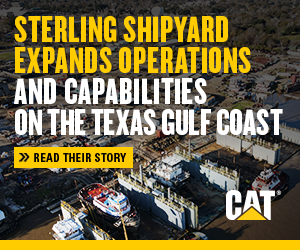Karl Senner LLC Touts Hybrid Power Systems For Towing Vessels
In 2019, the quest for efficiency and clean energy—while also preserving power and range—is a worldwide pursuit. Renewable energy sources, engine emission regulations and electric vehicles (EVs) garner daily headlines.
The same is true on the inland waterways of the United States as towing companies seek greater fuel efficiency aboard towboats while adhering to EPA Tier III and Tier IV standards. Vessel designers, builders and suppliers have put forth a number of options, from powering vessels with liquefied natural gas (LNG) to using only generators to drive a vessel’s thrusters or even stacking multiple smaller diesel engines to a single gearbox.
Two key systems already proven include mechanical-electric hybrid, which combines a traditional diesel-mechanical interface with the addition of an electric motor, and diesel-electric, where onboard generator sets or onboard batteries power one or more electric motors to drive propulsion and other systems.
One proven solution is from Karl Senner LLC, the exclusive North American sales and service distributorship for Reintjes Power Train Solutions. The company is also the sales and service representative for Steerprop in the United States, Mexico and Bahamas, and the EPD (Electronic Power Design) marine representative in North America.
Reintjes, the German marine gearbox manufacturer with locations on every continent other than Antarctica, has offered hybrid ready gearboxes for more than 20 years. Since 2011, Reintjes has offered the Reintjes Hybrid System, which includes the company’s signature gearbox, an electric motor and generator, frequency converter and couplings. The entire system offers a range of operation modes to meet the full spectrum of situational needs aboard workboats.
Karl Senner, grandson of the founder of Karl Senner LLC, said, with the Reintjes Hybrid System, inland towboat operators benefit from the reliability and performance of a Reintjes gearbox along with a well-tested electrical system. Senner added these systems and diesel-electric systems are far from new.
“It’s new to the inland market, but this is not a new concept,” Karl Senner said of the diesel-electric and hybrid concepts. “We have delivered similar systems for around 180 vessels with both Z-drives and shafted propeller arrangements through a gearbox. Now we’re seeing this proven technology gain interest on the inland waterways.”
The Reintjes Hybrid System offers vessel operators with a PTI mode (Power Take In), where the only the onboard electric motor drives the propellers. According to Reintjes, PTI mode is designed for normal cruising, maneuvering and reversing at slow speeds. Power comes from the vessel’s genset or batteries. In PTO mode (Power Take Off), the electric motor serves as a generator, with power from the electric motor going into the ship’s grid as an assist to generators. Boost mode combines power from both the electric motor and the diesel engine in situations that require higher speed and thrust. Finally, the system offers a diesel mode where only the diesel engine drives a shafted propeller or Z-drive. Hydraulically-operated clutches allow ship operators to switch seamlessly between modes.
Karl Senner said the Reintjes Hybrid System can be applied to virtually any horsepower range, based on a vessel’s particular area of operation or needs.
“That means anything from 600 hp. all the way up to a big 10,000 or 11,000 hp. towboat can use the hybrid system to gain efficiencies,” he said. “That also includes the system’s boost capability, which could allow operation of a Tier III engine on a shaft line delivering more than 800 hp.”
Karl Senner added that the system works with both conventional shaft lines and Z-drives.
Chris Senner, also a grandson of company founder Karl Senner, said another benefit of diesel-electric is that the system drives propulsion with electric motors throughout the entire power range of the vessel.
“This provides excellent slow speed control and fast response times,” Chris Senner said. “The operator can choose to only run the generators needed for the demand onboard. Vessels can operate full power upriver and reduce power accordingly when venturing downriver. This results in generator engines operating at better loads and allocates time and fuel burn to smaller engines, as opposed to two large main engines, thus increasing the time between overhauls and reducing maintenance expenses.”
Designing a diesel-electric system around Tier III engines only enhances the operational savings to the operator and closes the capital expense gap, Chris Senner said.
“Both mechanical-electric hybrid and diesel-electric systems allow for the utilization of Tier III engines by utilizing electrical motors and switchgear,” he said.



